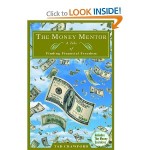I didn’t expect to like The Money Mentor: A Tale of Financial Freedom by Tad Crawford. Crawford wrote this modern-day fable aimed most at people who struggle with high-interest debt. The Money Mentor in that sense is a modern-day version of George Clason’s The Richest Man in Babylon.
We meet the narrator/protagonist Iris, a 20-something wannabe dancer in the big city, with multiple body piercings, dead-end jobs, and out-of-control credit card debt. She’s not exactly the profile of someone from whom I’m looking to learn about finance, even if I am – admittedly – picturing Rooney Mara in the starring role.
In the first chapter, Iris receives a very stern, one-way talking-to, by her tone-deaf dentist about the evils of credit card debt. The author seems to have set up the dentist as a foil to contrast with Iris’ eventual money mentor.
The dentist – I’m picturing Steve Martin in this hyper-talkative, annoying role – represents both preachy personal finance books, as well as any smarmy adult who does not take the time to understand the particular challenges of the heavily indebted.

Finally, we meet the Money Mentor, Saidah, as the we’ve-seen-this-cliché-before wise African-American woman. Believe me when I say I was skeptical of this Oprah-meets-Sonia-Sotomayor-fairy-godmother character.
The weird thing is this: I really enjoyed the book.
Iris/Rooney Mara doesn’t live like me, but Crawford writes well enough to create a sympathetic character.
Ninety-five percent of us have probably felt like her at some point – there’s not enough at the end of the month to pay all of our bills. We don’t know who to ask for help. Maybe we should just give in to the feeling that it can’t get any better and sink further into the debt? Is it all just too hard to get ahead so why bother?
One-half of all Americans do carry a credit card balance month to month.
Most of us do need a wise money mentor in our life, and typically the adults in our life either do not have the answers, or do not have the empathy to show us where to find them.
Saidah understands because, as we learn, she once faced heavy debts herself. Saidah listens, and Saidah suggests solutions. When Iris inevitably ignores her suggestions, Saidah repeats herself patiently.
I expected Iris to meet Saidah and then, in the typical arc of redemption stories, suddenly get her act together and pay off her debts.
But Crawford is a better writer than that. He depicts a fuller story of one step forward, two steps back for Iris. Things get worse before they get better. Like all of us, Iris vacillates between self-pity and self-confidence, good decisions and bad, willful blindness and occasional insight, eagerness to see her mentor and avoidance of her mentor from shame at her poor choices.
I knew The Money Mentor was a keeper when I got to the chapter when Iris watches It’s a Wonderful Life, and she’s inspired by the Christmas classic to take an important step forward in her journey to solvency. Careful readers of Bankers Anonymous will recognize that the movie similarly touched me.
In Iris’ case, the realization that she needed help from others led her to try Debtors Anonymous, a 12-step support group for people ready to make a change in their relationship to debt.
Money problems stem from a cash-flow deficit and our own psychological relationship with money. Solving the problem of high interest debt requires a combination of psychological change and cash flow management.
Many finance books I have read risk erring on the side of the dentist – a tone-deaf, one-way lecture on the right way to be.
But who wants to hear that? Most of us do not learn that way.
Crawford’s fictional fable allows space for the psychological, the irrational, and the personal in addressing our finances. I really liked this one.
Please see related post Become a Money-saving Jedi.
Please see related post Book Review of George Clason’s The Richest Man in Babylon
Please see related post All Bankers Anonymous books reviewed, in one place
Post read (7147) times.




